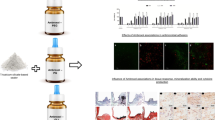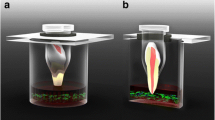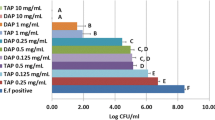Abstract
Objectives
Evaluate the cytotoxicity and biocompatibility of calcium hydroxide paste [Ca (OH)2] associated with 5% diclofenac sodium, ibuprofen, or amoxicillin.
Materials and methods
Pre-osteoblast-like cells were cultivated and the MTT test was used to determine the cytotoxicity of the paste extracts after time intervals of 24, 48, 72 h, and 7 days. Tubes containing Ca (OH)2 pastes associated with the drugs and empty tubes were implanted in subcutaneous tissue of 30 rats. After 7 and 30 days, the specimens were removed and submitted to histological analysis. The data obtained were submitted to Kruskal-Wallis and Dunn tests (p ≤ 0.05).
Results
All the Ca (OH)2 pastes promoted cell viability after all periods. At 7 days, there was greater inflammatory tissue reaction adjacent to the implants. At 30 days, there was a significant reduction in the number of inflammatory cells, and increase in fibroblasts in all groups. In this period, a lower number of inflammatory cells and a higher number of fibroblasts were observed in the capsules adjacent to the association with diclofenac, when compared with the other mixtures (p ≤ 0.05); the capsule thickness was greater at 7 days than at 30 days.
Conclusions
The Ca (OH)2 pastes associated with the drugs were not cytotoxic and presented biocompatibility after implantation in rat subcutaneous tissues.
Clinical relevance
Ca (OH)2 pastes with anti-inflammatory or antibiotic may be clinical alternatives as intracanal medication to reduce resistant microorganisms in root canal system.

Similar content being viewed by others
References
Desai S, Chandler N (2009) Calcium hydroxide–based root canal sealers: a review. J Endod 35:475–480
Mizuno M, Banzai Y (2008) Calcium ion release from calcium hydroxide stimulated fibronectin gene expression in dental pulp cells and the differentiation of dental pulp cells to mineralized tissue forming cells by fibronectin. Int Endod J 41:933–938
Siqueira JF, Lopes HP (1999) Mechanisms of antimicrobial activity of calcium hydroxide: a critical review. Int Endod J 32:361–369
Tanomaru JM, Leonardo MR, Tanomaru Filho M, Bonetti-Filho I, Silva LA (2003) Effect of different irrigation solutions and calcium hydroxide on bacterial LPS. Int Endod J 36:733–739
Pinheiro ET, Gomes BP, Ferraz CCR, Sousa EL, Teixeira FB, Souza-Filho FJ (2003) Microorganisms from canals of root-filled teeth with periapical lesions. Int Endod J 36:1–11
Valverde ME, Baca P, Ceballos L, Fuentes MV, Ruiz-Linares M, Ferrer-Luque CM (2017) Antibacterial efficacy of several intracanal medicaments for endodontic therapy. Dent Mater J 36:319–324
Freitas RP, Greatti VR, Alcalde MP, Cavenago BC, Vivan RR, Duarte MAH, Weckwerth ACV, Weckwerth PH (2017) Effect of the association of nonsteroidal anti-inflammatory and antibiotic drugs on antibiofilm activity and pH of calcium hydroxide pastes. J Endod 43:131–134
Dastidar SG, Ganguly K, Chaudhuri K, Chakrabarty AN (2000) The anti-bacterial action of diclofenac shown by inhibition of DNA synthesis. Int J Antimicrob Agents 14:249–251
Salem-Milani A, Balaei-Gajan E, Rahimi S, Moosavi Z, Abdollahi A, Zakeri-Milani P, Bolourian M (2013) Antibacterial effect of diclofenac sodium on Enterococcus faecalis. J Dent (Tehran) 10:16–22
ISO-1993-6 (2009) Biological evaluation of medical devices - part 5: tests for in vitro cytotoxicity. International Standards Organization, Switzerland, pp 1–34
Mossman T (1983) Rapid colorimetric assay for cellular growth and survival: application to proliferation and cytotoxicity assays. J Immunol Methods 65:55–63
Oliveira FA, Matos AA, Santesso MR, Tokuhara CK, Leite AL, Bagnato VS, Machado MA, Peres-Buzalaf C, Oliveira RC (2016) Low intensity lasers differently induce primary human osteoblast proliferation and differentiation. J Photochem Photobiol B 163:14–21
ISO-7405 (2008) Evaluation of biocompatibility of medical devices used in dentistry. International Standards Organization, Switzerland, pp 1–34
Stanford JW (1986) Recommendations for determining biocompatibility and safety for the clinical use of metals in dentistry. Int Dent J 36:45–48
Taha NA, Safadi RA, Alwedaie MS (2016) Biocompatibility evaluation of EndoSequence root repair paste in the connective tissue of rats. J Endod 42:1523–1528
Cintra LTA, Benetti F, Queiroz IOA, Ferreira LL, Massunari L, Bueno CRE, de Oliveira SHP, Gomes-Filho JE (2017) Evaluation of the cytotoxicity and biocompatibility of new resin epoxy–based endodontic sealer containing calcium hydroxide. J Endod 43:2088–2092
Tronstad L, Wennberg A (1980) In vitro assessment of the toxicity of filling materials. Int Endod J 13:131–138
Peters OA (2013) Research that matters: biocompatibility and cytotoxicity screening. Int Endod J 46:195–197
Althumairy RI, Teixeira FB, Diogenes A (2014) Effect of dentin conditioning with intracanal medicaments on survival of stem cells of apical papilla. J Endod 40:521–525
Holland R, Pinheiro CE, Mello W, Nery MJ, Souza V (1982) Histochemical analysis of the dogs dental pulp after pulp capping with calcium, barium, and strontium hydroxides. J Endod 8:444–447
Estrela C, Sydney GB, Bammann LL, Felippe-Júnior O (1995) Mechanism of action of calcium and hydroxyl ions of calcium hydroxide on tissue and bacteria. Braz Dent J 6:85–90
Faria G, Celes MRN, Rossi A, Silva LAB, Silva JS, Rossi MA (2007) Evaluation of chlorhexidine toxicity injected in the paw of mice and added to cultured L929 fibroblasts. J Endod 33:715–722
Andolfatto C, da Silva GF, Cornélio AL, Guerreiro-Tanomaru JM, Tanomaru-Filho M, Faria G, Bonetti-Filho I, Cerri PS (2012) Biocompatibility of intracanal medications based on calcium hydroxide. ISRN Dent 2012:904963
Jayant RD, McShane MJ, Srivastava R (2011) In vitro and in vivo evaluation of anti-inflammatory agents using nanoengineered alginate carriers: towards localized implant inflammation suppression. Int J Pharm 403:268275
Silveira CM, Pinto SC, Zedebski Rde A, Santos FA, Pilatti GL (2011) Biocompatibility of four root canal sealers: a histopathological evaluation in rat subcutaneous connective tissue. Braz Dent J 22:21–27
Montero-Miralles P, Martín-González J, Alonso-Ezpeleta O, Jiménez-Sánchez MC, Velasco-Ortega E, Segura-Egea JJ (2018) Effectiveness and clinical implications of the use of topical antibiotics in regenerative endodontic procedures: a review. Int Endod J 51:981–988
Author information
Authors and Affiliations
Corresponding author
Ethics declarations
Conflict of interest
The authors declare that they have no conflict of interest.
Ethical approval
All applicable international, national, and/or institutional guidelines for the care and use of animals were followed.
Informed consent
For this type of study, formal consent is not required.
Additional information
Publisher’s note
Springer Nature remains neutral with regard to jurisdictional claims in published maps and institutional affiliations.
Rights and permissions
About this article
Cite this article
da Silva, G.F., Cesário, F., Garcia, A.M.R. et al. Effect of association of non-steroidal anti-inflammatory and antibiotic agents with calcium hydroxide pastes on their cytotoxicity and biocompatibility. Clin Oral Invest 24, 757–763 (2020). https://doi.org/10.1007/s00784-019-02923-y
Received:
Accepted:
Published:
Issue Date:
DOI: https://doi.org/10.1007/s00784-019-02923-y




